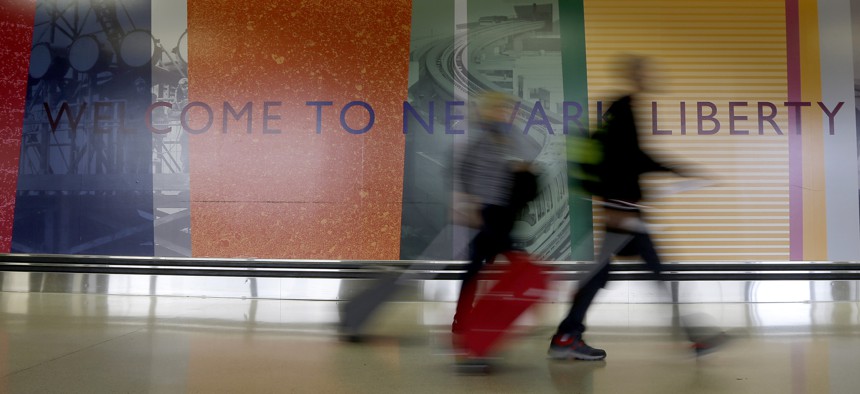
Travelers walk with their luggage after exiting the customs and immigration area at the international arrivals terminal at Newark Liberty International Airport, Oct. 26, 2017, in Newark, N.J. AP / Julio Cortez
DHS’s New Plan for Refugee Screening Looks a Lot Like TSA PreCheck
Forget bans. Risk-based screening is the new way to vet refugees, and it could be useful for visa applicants as well.
Refugees from 11 "high risk" countries whom the Trump administration tried to bar from the United States will once again be allowed to enter — if they clear a new, additional set of background checks, a senior administration official said Monday. That puts an end to the “travel ban” that the administration attempted to impose — and quietly stopped enforcing in October — and also makes refugee screening a bit more like TSA PreCheck.
Department of Homeland Security officials said the new measures introduce a “more risk-based approach to administering” the United States Refugee Admissions Program, or USRAP.
What will that look like? The official offered few details during a call with reporters on Monday but did say that the potential risks associated with letting in a given refugee would weigh more heavily in approving or rejecting his or her application.
That’s similar to the way the Transportation Security Administration’s PreCheck program works. Travelers who want to move through airport security more quickly can submit to a government background check and fingerprinting, allowing TSA guards to ignore people who don’t pose a threat to passenger aircraft, which, of course, is almost all of them.
Senior administration officials said PreCheck is not entirely analogous to the new refugee screening, but the gist of the two was the same. “We are trying to make sure we devote the right resources to the right risk levels. In that sense, yes. We are trying to take a more risk-based approach in general. Aviation security programs are also risk-based,” said the official.
Of course, refugees seeking entry into the United States are screened by representative of the UN High Commissioner for Refugees. The UNHCR screening includes fingerprint scanning, live interviews, photographs, and more. As Defense One reported in 2015, “UN workers determine whether a refugee falls into any of about 45 ‘categories of concern,’ from serving in particular government ministries or military units to being in specific locations at specific times, even missing family members.”
The official said that the new procedures were intended to add to the UNHCR is doing. “The UN do conduct some initial checks on applicants. Their checks are qualitatively different from what is done by a government like the United States government,” said the official. “We have access to far, far more information from an intelligence, law enforcement and homeland security standpoint, which we use to conduct our background checks…Whether it’s refugees, VISA applicants, really just about any route you would use to come to the United States, we possess far more information that you would need to make sure they don’t represent a security threat to our country.”
And if the government can figure out how to do PreCheck-style screening on far larger groups, it could be applied to all prospective immigrants, speeding up the process, said Sheldon H. Jacobson, an aviation security expert and computer science professor at the University of Illinois.
“I would say that a PreCheck-style program could make sense for immigration vetting. One can argue that is what immigration vetting is anyways,” Jacobsen said. “What is unknown is: what criteria would go into the vetting process that would lead to crime reduction among such candidates? As for scaling, it depends on the criteria that are used in the background-checking process. Given that around 1,000,000 people immigrate per year into the U.S., that translates into around 4,000 people being processed each workday.”
But is any of this extra screening actually necessary? Neither the White House nor the Department of Homeland Security have offered data to show that refugees pose more of a threat to than anyone else. To the contrary, statistics compiled by the libertarian-leaning CATO Institute show that refugees from at-risk countries have never executed a deadly terror attack in the United States.





